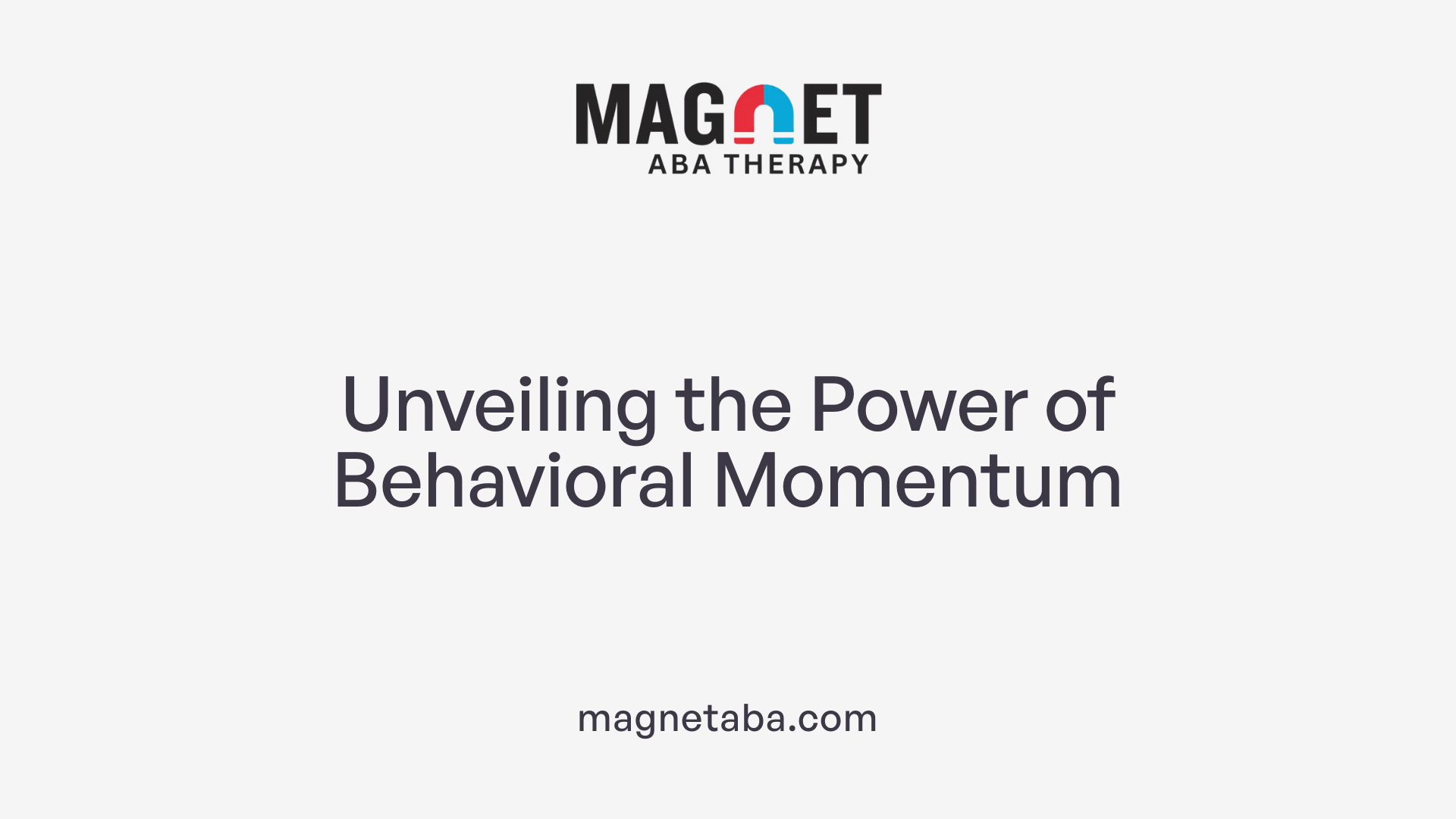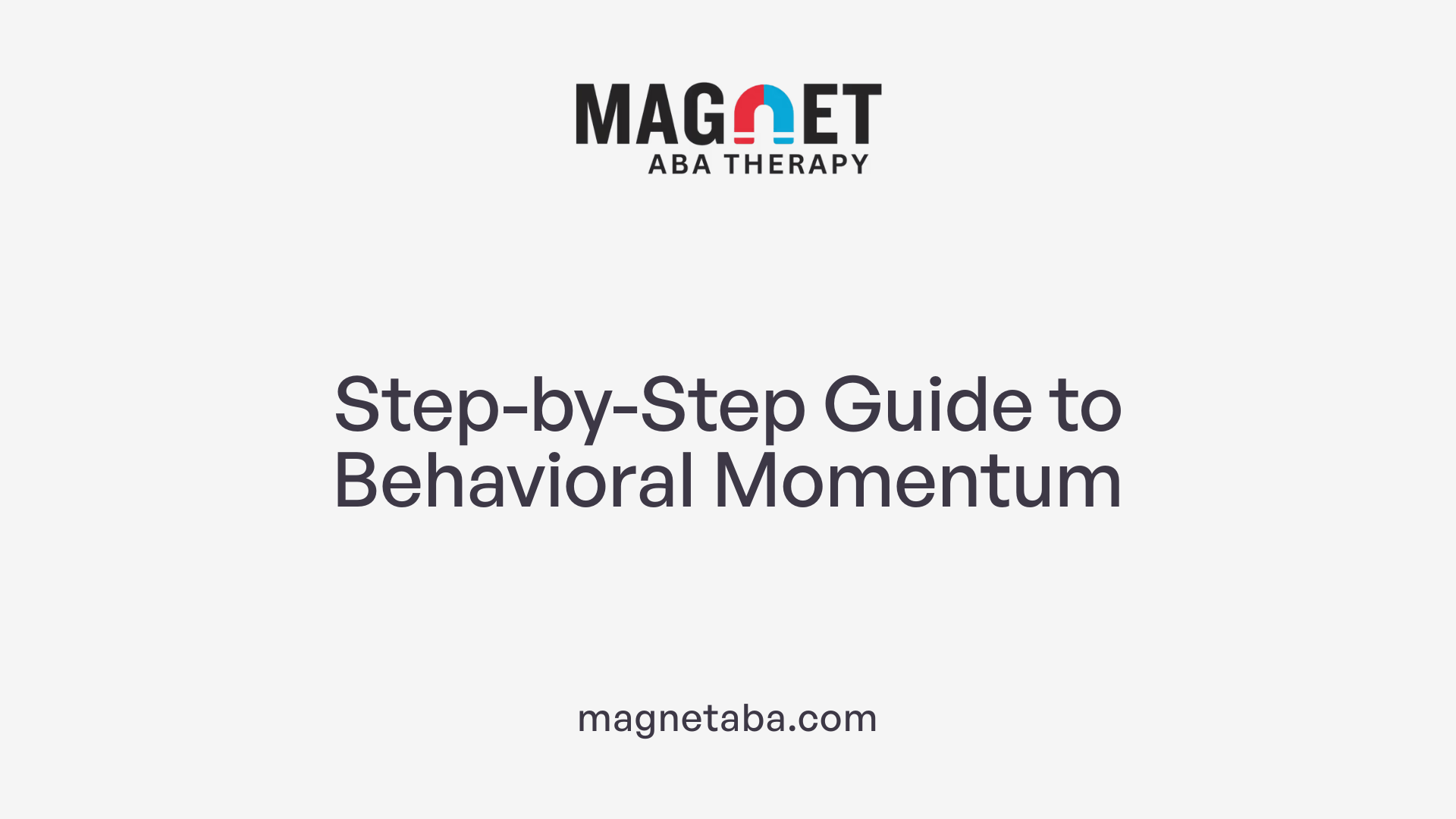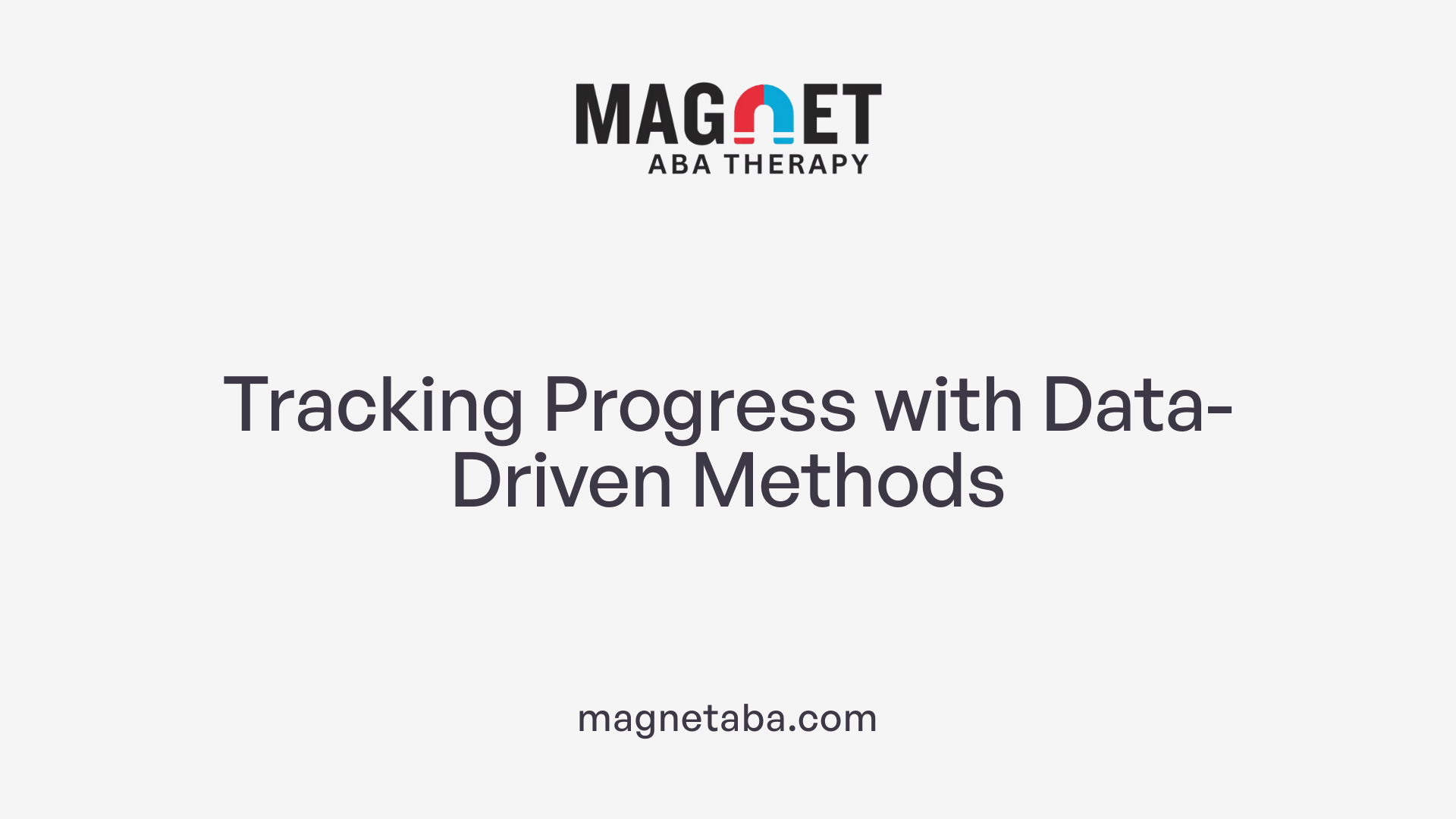Introducing Behavioral Momentum in ABA Therapy
Applied Behavior Analysis (ABA) therapy has long been a cornerstone in supporting individuals with autism spectrum disorder (ASD). Among the variety of evidence-based techniques ABA employs, behavioral momentum stands out as an effective method for increasing task initiation and compliance. By strategically structuring demands and leveraging success with easier tasks, this approach fosters smoother transitions to challenging activities, ultimately enhancing therapeutic outcomes. This article explores how behavioral momentum works, its foundation in ABA, and how it integrates with other behavioral techniques to promote skill acquisition and reduce resistance in individuals with ASD.
Understanding Applied Behavior Analysis (ABA) Therapy

What is Applied Behavior Analysis (ABA) therapy?
Applied Behavior Analysis (ABA) therapy is a scientifically based approach that applies principles of learning and behavior to help individuals improve skills and decrease problematic behaviors. ABA focuses on teaching and reinforcing positive behaviors such as communication, social interactions, and academic abilities, while minimizing behaviors that interfere with daily functioning.
What are the scientific foundations and principles of ABA?
ABA is grounded in behaviorism, relying on systematic observations of behavior and its relationship with the environment. It uses techniques such as positive reinforcement to encourage desired behaviors, environmental analysis through the A-B-C model (Antecedent, Behavior, Consequence), and data-driven adjustments. This empirical foundation ensures interventions are effective and tailored to each learner's needs.
In which settings and through which methods is ABA delivered?
ABA therapy is versatile, administered across settings including homes, schools, and clinics. Therapists employ various methods like Discrete Trial Training (DTT), which breaks skills into small manageable steps with prompts and reinforcements; Natural Environment Training (NET), which uses routine activities and play for teaching; and Verbal Behavior Therapy (VBT) focusing on communication skills. These diverse techniques support skill acquisition in real-life contexts.
What professional roles are involved in ABA therapy?
Qualified professionals such as Board Certified Behavior Analysts (BCBAs) develop and oversee individualized treatment plans. Trained therapists provide direct intervention and collect data to monitor progress. This team-based approach ensures the therapy is implemented effectively and adjusted based on continual assessment.
What are the objectives and expected outcomes of ABA?
The primary goal of ABA is to promote meaningful developmental gains and greater independence, particularly for individuals with autism spectrum disorder (ASD) and other developmental challenges. It aims to enhance communication, social abilities, academic skills, and adaptive behaviors while reducing problematic behaviors. Through consistent intervention and data monitoring, ABA supports effective skill mastery and improves quality of life.
Benefits of ABA Therapy for Individuals with Autism

How does ABA therapy benefit individuals with autism?
ABA therapy offers comprehensive benefits for individuals with autism by systematically promoting positive behaviors and reducing challenging ones. Through evidence-based methods like positive reinforcement, it enhances crucial skills including communication, social interaction, language development, and daily living activities. These improvements foster greater independence and functional abilities.
The therapy is highly personalized, with individualized goals set through detailed assessments. Ongoing monitoring of progress ensures that interventions remain effective and adjustment can be made to suit each learner’s evolving needs.
Early intervention with ABA, particularly before the age of six, has demonstrated significant developmental gains. Intensive ABA programs harness this critical window to maximize improvements in skill acquisition and behavioral regulation.
By focusing on functional and socially meaningful skills, ABA therapy not only advances learning but also elevates overall quality of life. This includes better engagement, reduced frustration from challenging behaviors, and increased autonomy across home, school, and community settings.
How does ABA support skill development and reduce challenging behaviors?
Skill Development Improvements: ABA teaches new skills by breaking them into manageable steps using techniques such as Discrete Trial Training, Natural Environment Training, and Task Analysis. Verbal Behavior Therapy enhances communication, while Pivotal Response Treatment focuses on motivation and social responses.
Reduction of Challenging Behaviors: Behavioral Momentum and Functional Communication Training are used to increase compliance and teach alternative communication strategies, reducing escape behaviors and agitation.
Personalized Goal Setting and Monitoring: ABA programs rely on continuous data collection methods to tailor interventions and track progress precisely.
Early Intervention Impact: Earlier initiation of ABA treatment correlates with greater developmental progress.
Quality of Life Enhancement: Structured learning, behavioral improvements, and increased communication capacities contribute to improved daily functioning and social involvement.
By integrating proven ABA techniques and customizing therapy plans, individuals with autism receive support that promotes meaningful progress and long-term positive outcomes.
Qualified Providers Delivering ABA Therapy
Who provides ABA therapy and what qualifications do they have?
ABA therapy is delivered by a range of professionals specialized in behavioral analysis and autism treatment. The most recognized providers include Board Certified Behavior Analysts (BCBAs), ABA therapists, clinical supervisors, and behavioral specialists.
Professional roles and qualifications
BCBAs are typically at the top level of ABA service providers. They possess advanced knowledge in behavior analysis and are responsible for conducting assessments, designing individualized intervention plans, and overseeing therapy implementation. ABA therapists often work under the supervision of BCBAs and apply prescribed interventions directly with clients.
Education and certification paths
Individuals interested in providing ABA therapy usually start with a relevant bachelor's degree followed by a master's degree in applied behavior analysis or a related field. After academic training, candidates gain supervised practical experience.
To become certified as a BCBA, candidates must meet the Behavior Analyst Certification Board (BACB) requirements, which include completing approved coursework, accumulating required supervised fieldwork hours, and passing a comprehensive examination.
Supervised field experience
Supervised fieldwork allows prospective providers to apply ABA principles in real-world settings while receiving guidance from experienced professionals. This hands-on experience is critical to develop clinical decision-making skills and effective intervention strategies.
Responsibilities in assessment and intervention
Qualified ABA providers conduct functional behavior assessments, develop behavior intervention plans, and implement evidence-based techniques such as positive reinforcement, prompting, and behavioral momentum. They monitor progress, adjust strategies as needed, and collaborate with families and other professionals.
Ethical and continuing education standards
ABA providers adhere to ethical standards outlined by the BACB, ensuring client dignity, confidentiality, and professional integrity. Ongoing continuing education is mandatory to maintain certification and stay current with advancements in ABA research and practice.
These rigorous qualifications and responsibilities ensure that ABA therapy is delivered effectively, ethically, and tailored to individual learner needs.
Key Techniques in ABA Therapy

What techniques are commonly used in ABA therapy?
ABA therapy employs various techniques designed to promote learning and reduce challenging behaviors, especially in individuals with autism. Positive reinforcement is a cornerstone technique that rewards desired behaviors immediately after they occur, increasing the likelihood of their repetition. Prompting assists learners in initiating behaviors by providing cues, which are gradually faded to promote independence.
Visual modeling is another powerful tool, using pictures, charts, and other visual aids to teach skills in a clear and engaging manner. This method supports learning by making abstract concepts concrete, especially for children who benefit from visual supports.
Behavior chaining breaks down complex tasks into smaller, manageable steps taught sequentially, allowing learners to master each component before moving on. Behavior contracts clearly outline expectations with associated rewards or consequences, creating structured motivation.
Additional strategies include extinction, which decreases unwanted behaviors by withholding reinforcement, and redirection, which guides attention away from problematic actions toward positive alternatives. Script fading is used to improve social scripts and communication by gradually removing prompts.
Importantly, data collection is integral to ABA, enabling therapists to monitor progress and adjust approaches. Individualized treatment plans are developed based on this data, addressing the unique needs of each learner to maximize outcomes.
Together, these techniques form a comprehensive framework that supports meaningful behavioral improvements in diverse settings, from homes to schools and clinics.
The Principle of Behavioral Momentum in ABA

What is Behavioral Momentum and How Does It Compare to Physical Momentum?
Behavioral momentum in Applied Behavior Analysis (ABA) is a strategy that uses a sequence of easy, high-probability tasks to build compliance before introducing more challenging, low-probability demands. Similar to physical momentum, where movement gained from easy actions helps propel an object forward, behavioral momentum leverages initial successes to promote persistence and response initiation in individuals, especially those with autism spectrum disorder (ASD).
What Roles Do High-Probability and Low-Probability Behaviors Play?
High-probability (high-p) behaviors are tasks the learner readily performs and finds enjoyable or easy. By requesting these first, therapists create a chain of positive responses. Following this, low-probability (low-p) behaviors—typically more difficult or less preferred tasks—are introduced. This sequencing fosters a greater likelihood of compliance with challenging demands by building momentum through initial successes.
How Does Reinforcement History Influence Behavioral Momentum?
Reinforcement history is crucial; consistent positive reinforcement following high-p tasks strengthens behavioral persistence even when a learner faces more difficult demands. Studies highlight that a dense schedule of reinforcement increases the likelihood that the individual will continue responding despite disruptions or challenging tasks, effectively increasing resistance to noncompliance.
In What Ways Does Behavioral Momentum Promote Compliance and Task Initiation?
This approach eases transitions and helps manage unexpected requests or escape behaviors by first engaging learners in simple tasks. The momentum created by these quick successes raises confidence and motivation, which in turn facilitates the initiation and completion of more complex tasks, improving on-task behavior and reducing resistance.
What Does Research Say About Behavioral Momentum?
Empirical evidence supports behavioral momentum’s effectiveness in enhancing compliance and task initiation across various ABA settings. For instance, research by Davis et al. (1992) and other studies demonstrate improved compliance rates and faster task completion in children with ASD when high-p request sequences precede low-p demands. These findings affirm behavioral momentum as a powerful tool in behavioral therapy.
| Aspect | Description | Impact |
|---|---|---|
| Behavioral analogy | Compares behavioral momentum to physical momentum in everyday physics | Helps conceptualize task sequencing and success buildup |
| High-p behaviors | Easy, enjoyable tasks that learners readily comply with | Builds initial compliance and confidence |
| Low-p behaviors | Challenging tasks with lower likelihood of compliance | Main target behaviors for improvement |
| Reinforcement history | Prior reinforcement strengthens response persistence | Increases resistance to disruption and task refusal |
| Research evidence | Studies show increased compliance and persistence when using behavioral momentum | Validates clinical application in autism therapy |
Implementing Behavioral Momentum: Strategies and Steps

Identification of High-p and Low-p Tasks
Behavioral momentum starts by identifying high-probability (high-p) tasks, which are easy or enjoyable for the learner, and low-probability (low-p) tasks, which tend to be more challenging or less preferred. High-p tasks might include simple commands or fun activities, ensuring the learner is more likely to comply immediately.
Sequential Delivery of Demands
Once high-p and low-p tasks are defined, the technique involves delivering the high-p demands quickly and in succession. This builds a momentum of compliance that naturally primes the learner to respond to the subsequent low-p requests with greater willingness.
Securing Learner's Attention
For demands to be effective, they must be stated clearly at moments when the learner's attention is fully secured. This focus increases likelihood that the learner understands the request and is prepared to respond, reducing chances of resistance or confusion.
Reinforcement Following High-p Behavior
After each high-p demand compliance, immediate positive reinforcement is provided to strengthen the behavior. Reinforcers can range from verbal praise to preferred items or activities, fostering motivation and further compliance.
Combining with Choices and Assent for Engagement
To enhance learner autonomy and engagement, behavioral momentum can be combined with offering choices and obtaining assent before tasks. This respectful approach encourages participation, builds trust, and may reduce resistance—especially important during transitions or challenging tasks.
These strategies support effective behavioral momentum implementation, enhancing compliance and easing transitions in autism therapy settings.
Behavioral Momentum Enhancing Task Initiation and Compliance
How Does Behavioral Momentum Increase the Likelihood of Starting Tasks?
Behavioral momentum increases task initiation by leveraging high-probability (high-p) behaviors, which are easy and enjoyable for the learner. By asking for these simple tasks first, it builds momentum, making it more likely the learner will engage in subsequent, more challenging low-probability (low-p) tasks. This method draws on positive reinforcement and quick succession of requests, creating a sequence where success encourages compliance.
How Does Behavioral Momentum Ease Transitions and Unexpected Demands?
Transitions or unexpected requests often trigger resistance. Behavioral momentum helps by starting with familiar, enjoyable tasks that capture the learner’s attention and confidence. This positive interaction creates a smooth bridge to less preferred demands, reducing stress and resistance during changes in routine or unplanned situations.
How Does Behavioral Momentum Help Reduce Escape-Maintained Behaviors?
Escape-maintained behaviors—where learners try to avoid tasks—are reduced by first presenting high-p tasks that are less likely to provoke avoidance. As the learner complies with these easy requests and receives reinforcement, the increased momentum decreases the likelihood of escape behaviors when more difficult tasks are introduced.
How Does Behavioral Momentum Improve On-Task Performance?
By structuring tasks from simple to complex and reinforcing compliance frequently, behavioral momentum sustains the learner’s engagement. This approach builds confidence and focus, which enhances overall task completion rates and reduces noncompliance, especially in individuals with autism spectrum disorder.
How Effective Is Behavioral Momentum Across Different Settings?
Behavioral momentum is versatile and effective across homes, schools, and clinical environments. Research shows that it can significantly improve compliance and skill acquisition when integrated with other ABA techniques such as prompting, reinforcement, and offering choices. Studies indicate that this method boosts educational and therapeutic outcomes by promoting engagement and reducing resistance to task completion.
Integration of Behavioral Momentum with Other ABA Techniques
Positive reinforcement and prompting synergy
Behavioral momentum works seamlessly with positive reinforcement and prompting strategies. After successfully completing high-probability (high-p) tasks, learners receive reinforcement, which strengthens motivation and encourages engagement in subsequent, more challenging low-p requests. Prompting during task sequences supports correct responses, reducing errors and building confidence alongside behavioral momentum.
Task analysis and behavior chaining support
Task analysis breaks complex skills into manageable steps, which complements behavioral momentum by structuring easy, achievable demands first. Behavior chaining methods—forward, backward, or total task teaching—help learners complete these sequences successfully. This structured approach increases compliance and smoothly transitions the individual through successive tasks.
Use with token systems and visual supports
Combining behavioral momentum with token systems enhances reinforcement by allowing learners to earn tangible rewards after completing high-p requests, sustaining motivation. Visual supports, such as picture schedules or social stories, aid comprehension and task initiation, strengthening adherence to instruction sequences established by behavioral momentum techniques.
Errorless teaching complements
Errorless teaching minimizes mistakes through graduated prompting and immediate reinforcement, aligning with behavioral momentum's principle of securing early success. This reduces frustration during task progression, making it easier for learners to maintain momentum when moving from simple to more difficult tasks.
Enhancing social and communication skills
Behavioral momentum supports gains in social and communication behaviors when integrated with techniques like Verbal Behavior Therapy and Pivotal Response Treatment. Starting with easy, frequent requests fosters responsiveness, while behavioral momentum's momentum effect encourages persistent engagement, promoting meaningful improvements in social interaction and communication abilities.
Task Analysis: Breaking Down Complex Skills to Support Momentum
What is Task Analysis and What Are Its Goals?
Task analysis is a fundamental ABA method that involves breaking down complex skills or tasks into smaller, manageable steps. This systematic approach allows learners to master each step gradually, facilitating learning and building competence. The main goals are to increase mastery speed, reduce cognitive overload, and help the learner gain independence with complex skills.
What Are the Different Chaining Methods?
ABA employs three main chaining techniques to teach task sequences effectively:
- Forward Chaining: Teaching steps from the first to the last in sequence.
- Backward Chaining: Starting with the last step and working backward, so the learner completes the entire sequence progressively.
- Total Task Teaching: The learner is guided through all steps in a sequence during each session.
Each method has specific advantages. For example, backward chaining can provide immediate reinforcement through task completion, while forward chaining helps build the foundational steps first.
How Are Task Sequences Developed and Validated?
Developing an effective task analysis involves identifying the target skill and listing every sequential step required to complete it. Collaboration with team members or trial implementation helps validate the sequence, ensuring clarity and practical feasibility. This process prevents misunderstandings, such as confusing task expectations.
How Does Task Analysis Reduce Cognitive Load and Anxiety?
By dividing complex tasks into smaller parts, task analysis eases cognitive demands on the learner, making tasks less overwhelming. This method also promotes confidence and reduces anxiety by providing clear, achievable steps, supporting smoother transitions and increasing behavioral momentum.
Can Task Analysis Support Skill Generalization?
Yes. Task analysis helps learners apply learned skills across different settings and situations, increasing the likelihood of skill retention beyond the initial learning environment. This generalization is crucial for independence in daily living, academic tasks, and social interactions.
Measuring Success: Data-Driven Progress with Behavioral Momentum

How is data collected to measure progress in behavioral momentum?
Data collection in ABA therapy, including with behavioral momentum, typically uses structured methods like single-opportunity and multiple-opportunity assessments. These allow therapists to systematically record whether each task or demand is completed successfully and within expected parameters. The focus is often on compliance rates and task completion accuracy, which provide objective evidence of progress.
What methods are used to monitor compliance and task completion?
Monitoring involves tracking the frequency and consistency of compliance to both high-probability (high-p) and low-probability (low-p) requests. This includes measuring how quickly individuals transition from simpler to more difficult tasks and noting levels of resistance or noncompliance. Therapists often use checklists or digital data sheets to log responses immediately after each demand.
How are interventions adjusted based on collected data?
Data analysis helps identify patterns such as decreases in compliance or points where the learner struggles. Based on these insights, therapists can modify the sequence of requests, change reinforcement schedules, or adjust the difficulty of tasks. For example, adding more high-p requests before a challenging demand can strengthen behavioral momentum if compliance wanes.
What case evidence supports outcome tracking in behavioral momentum?
Research including studies by Davis et al. (1992) demonstrates that applying behavioral momentum increases compliance and task initiation. One particular hybrid ABA treatment model showed that 76% of patients exhibited upward trends in multiple goals concurrently, highlighting how data-driven monitoring underpins measurable improvements.
How do hybrid ABA models demonstrate improvements with behavioral momentum?
Hybrid models combine behavioral momentum with techniques like prompting, reinforcement, and task analysis, further enhancing engagement and success. These integrative approaches rely heavily on continuous data collection to adapt interventions dynamically, resulting in quicker and more efficient skill acquisition and reduced problem behaviors.
| Aspect | Description | Purpose |
|---|---|---|
| Data Collection Methods | Single- and multiple-opportunity recordings | Track task completion and compliance precisely |
| Compliance Monitoring | Recording responses to high-p and low-p requests | Identify behavioral trends and resistance points |
| Intervention Adjustment | Tailoring request sequences and reinforcement based on data | Enhance compliance and maintain momentum |
| Case Study Evidence | Empirical research showing increased compliance outcomes | Validate effectiveness of behavioral momentum |
| Hybrid ABA Integration | Combining momentum with prompts, reinforcement, and analysis | Maximize engagement and learning efficiency |
Future Directions: Expanding Use and Research on Behavioral Momentum

Ongoing studies and evidence synthesis
Current research continues to explore the effectiveness of behavioral momentum across diverse populations and settings. Systematic reviews and meta-analyses are being conducted to consolidate findings from multiple studies, enhancing understanding of how this technique improves compliance and task initiation in individuals with autism spectrum disorder (ASD).
Potential for broader applications
While primarily utilized in ASD therapy, behavioral momentum shows promise for use in other developmental disabilities and educational contexts. Early evidence suggests that the approach can be adapted to support behavioral interventions in schools and home environments, expanding its reach beyond clinical settings.
Tailoring momentum-based interventions
Future work emphasizes customizing behavioral momentum strategies to better suit individual learner profiles. This includes adjusting the selection and sequence of high-probability (high-p) and low-probability (low-p) tasks based on age, communication ability, motivation levels, and emotional state to maximize effectiveness.
Collaboration with multidisciplinary teams
Integrating behavioral momentum into multidisciplinary treatment plans involving speech therapists, occupational therapists, and educators promotes comprehensive support. Collaborative efforts facilitate the development of cohesive strategies that address social, communication, and daily living skills alongside compliance.
Promoting learner autonomy and engagement
Emerging approaches focus on balancing structured request sequences with techniques that enhance learner choice and assent. By combining behavioral momentum with opportunities for autonomy, practitioners aim to increase engagement and respect individual preferences, fostering a more positive therapeutic experience.
Harnessing Behavioral Momentum for Lasting Impact
Behavioral momentum represents a powerful and practical approach within the ABA therapy framework to enhance task initiation and improve compliance among individuals with autism. By thoughtfully sequencing high-probability requests that foster early success and confidence, therapists and caregivers can reduce resistance to challenges and promote sustained engagement. The technique’s foundation in established behavioral principles and robust research evidence ensures it remains a valuable addition to the arsenal of autism interventions. Integrating behavioral momentum with complementary ABA strategies such as task analysis, reinforcement, and prompting further optimizes therapeutic outcomes. As research and practice continue to evolve, behavioral momentum offers exciting potential to empower learners, enhance skill acquisition, and improve quality of life across diverse settings.
References
- Using Behavioral Momentum as an Antecedent Strategy
- ABA Therapy Techniques: Key Methods Explained
- Behavioral Momentum - an overview
- Understanding Behavioral Momentum in ABA Therapy
- Understanding Task Analysis in ABA Therapy
- How to Become an Applied Behavior Analyst (ABA) Therapist
- How to Become an ABA Therapist - School of Education
- Board Certified Behavior Analysts (BCBA)












